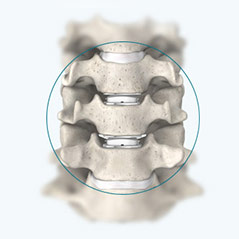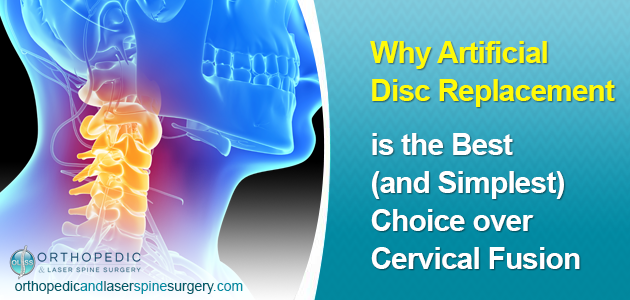Back and neck pain can be debilitating, significantly impacting your quality of life. If conservative treatments like physical therapy, medication, or spinal injections haven’t worked, you might be considering surgical options. One increasingly popular and…
Many back or neck pain sufferers agree that when it comes to the orthopedic health and well-being of yourself or those you love, finding a doctor you trust can be a tough decision. For many of our patients at OLSS, a crucial part of a positive healthcare experience and living a high quality of life is finding an orthopedic doctor who is both qualified to provide quality medical advice and willing to work with you or your family to find a unique treatment plan that best fits your needs and lifestyle.
Experiencing Neck Pain? Don’t Fall Victim to a Common Misdiagnosis
 If you or someone you love is experiencing neck pain and has ever been encouraged to undergo a cervical fusion to fix the problem – proceed with caution.
If you or someone you love is experiencing neck pain and has ever been encouraged to undergo a cervical fusion to fix the problem – proceed with caution.
Dr. Scott Katzman, OLSS’s leading spine surgeon, and world-renowned orthopedic industry leader, strongly urges his patients to receive a second opinion when it comes to cervical fusion as a solution to treat neck problems.
Making a smart decision on neck treatment is vital for undergoing a successful surgery process, which is why Dr. Katzman pushes for doctor-patient transparency to establish a relationship built on trust. At OLSS, the team of spine care experts is guided by these values as they work with patients suffering from neck pain due to a variety of common spine conditions – many of which have been misdiagnosed and wrongly recommended neck fusion as a surgical solution.
“Don’t let any doctor try to sell you a neck fusion,” Dr. Katzman says. “Why? First off, fusion procedures are associated with several misconceptions that many of the patients I see have fallen victim to.”
A cervical fusion locks in the motion in your neck and fuses together the vertebral discs in that area, which disables any movement that may be causing pain. Neck (or cervical) fusions are typically done to treat the pain caused by conditions like herniated discs, bone spurs, or pinched nerves.
Unfortunately in many of these cases, according to Dr. Katzman, the patients who end up undergoing a fusion have a low quality of life due to stiffness, a variety of painful side effects, and most unfortunately – for many, their initial condition returns and the patient is back to “square one” of seeking treatment for chronic neck pain.
Cervical Artificial Disc Replacement: The Smart, Long-Lasting Solution to Chronic Neck Pain

Because this procedure was recently developed within the last decade, not all spine surgeons are expertly skilled in performing them. In fact, about 95% of spine surgeons prefer to perform a cervical fusion over a cervical artificial disc replacement, due to a lack of experience with newly developed minimally invasive procedures.
“Ironically, these doctors who only perform fusions would most likely never opt for a fusion themselves,” says Dr. Katzman. “They would probably ask for a cervical artificial disc replacement because of the many advantages of seeking out a minimally invasive solution opposed to an invasive, intense procedure like fusion.”
An Analysis of Cervical Fusions
The advantages of cervical artificial disc replacements are best understood when the negative impacts of fusions are laid out, as well as what happens inside your body when a fusion is performed.
As previously mentioned, a cervical fusion limits the motion of the affected vertebrae that have been fused together. Immobility is not a natural state for the neck, so naturally, over time the vertebrae and discs surrounding the fused area begin to overwork and overcompensate for the lack of motion. Initially after surgery, this overcompensation can be a good thing, but in most cases, this motion ends up causing excessive wear and tear on those adjacent, moving segments, and a new condition, called adjacent segment disease, develops.
The process of going through a surgical procedure once is bad enough, but who wants to undergo a second neck surgery? This is what ends up happening when fusion complications – like adjacent segment disease – cause enough painful problems for the body to be unable to heal properly. Some patients may even develop a more serious surgery complication due to the body not accepting the fusion, which is called a cervical nonunion.
Cervical Nonunions Explained
A nonunion is a “failure to fuse” and almost always requires a second surgery to fix. If corrective surgery is not sought, the painful symptoms will only increase and create more interrelated issues along your spine.
Cervical nonunions can occur for a variety of reasons, ranging from post-surgical recovery methods to hereditary predispositions, but one of the most common – and preventable – reasons is smoking. Patients who smoke are at an increased risk of a failed cervical fusion, or nonunion, and Dr. Katzman recommends regular smokers consider an artificial disc replacement as a safer alternative with a higher chance of success.
Fix Your Neck Problems with Minimally Invasive Methods
At OLSS, our doctors specialize in minimally invasive treatment alternatives to traditional surgery for treating common neck and back conditions. Our expertise lies in fixing failed surgeries, with cervical artificial disc replacements making up over 25% of surgeries performed.
“We have patients coming in that require a cervical artificial disc replacement almost on a weekly basis,” says Dr. Katzman. “Our revision surgeries allow us to fix the problem at the root cause of pain, so we can get patients back on their feet and back to enjoying the life they once loved – free of chronic neck pain.”
Do you think you may be qualified for a cervical artificial disc replacement? Take our quick, 3-step Treatment Check Tool to self-diagnose and find out which treatment is best for you. For more information on Dr. Katzman and the rest of our internationally renowned team, visit our Doctors page.

